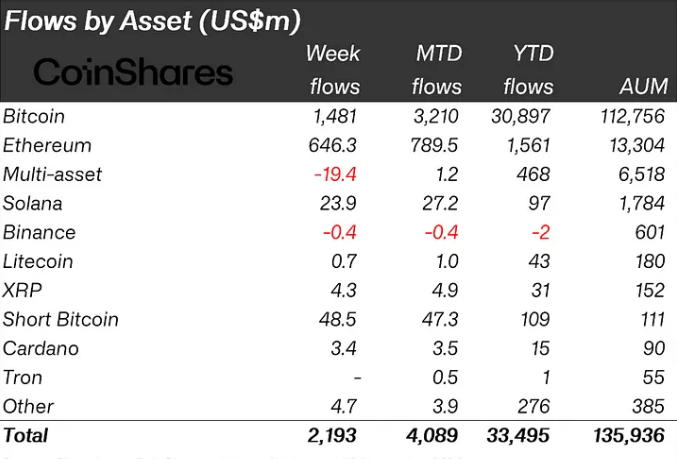-
Record crypto inflows are marking a pivotal moment in the digital asset landscape, spurred by favorable US elections and a shift in monetary policy.
-
The surge in investment activity highlights a growing institutional interest alongside retail participation in the cryptocurrency market.
-
“The convergence of political support and economic stimulus offers a promising environment for sustained growth,” noted an analyst from COINOTAG.
This week, crypto inflows soared nearly $2.2 billion, driven by US elections and Federal Reserve policies, marking a new high in market confidence.
Crypto Investment Inflows Near $2.2 Billion
According to a recent CoinShares report, crypto investment inflows reached an astonishing $2.2 billion in the past week. This surge is attributed to a combination of looser monetary policies from the Federal Reserve and significant political shifts following the US elections. These factors have notably enhanced investor sentiment within the digital asset market.
CoinShares’ analyst, James Butterfill, commented on the situation: “The combination of looser monetary policy alongside the Republican party’s clean sweep creates an optimistic environment for investors.”
Leading the pack, Bitcoin captured $1.48 billion of the inflows, underscoring its position at the forefront of the crypto ecosystem. However, this was somewhat countered by profit-taking activities that resulted in $866 million in outflows during the week’s latter half. Interestingly, there was $49 million in inflows into short Bitcoin products, suggesting a cautious approach among some investors amidst the market volatility.

On the other hand, Ethereum demonstrated resilience with a remarkable rebound, bringing in $646 million as inflows. This upward trend is largely attributed to the excitement surrounding the Beam Chain upgrade proposal by Ethereum researcher Justin Drake, which aims to make staking more inclusive by lowering the staking requirement from 32 ETH to just 1 ETH. This potential accessibility could invigorate the community and attract new participants.
Political and Economic Backdrop
The recent elections underscored a significant transformation in the political landscape, with 274 pro-crypto lawmakers being elected to Congress. This representation signifies a substantial shift towards more favorable regulatory conditions for cryptocurrency businesses and investors. In stark contrast, only 122 anti-crypto lawmakers were chosen, indicating a strong potential for legislative support in favor of digital assets.
In conjunction, the Federal Reserve‘s adjustments to monetary policy have provided much-needed liquidity to the markets. Analysts are quick to point out that such policies typically correlate with increased investments in riskier assets, including cryptocurrencies.

Moreover, former President Donald Trump‘s pro-crypto stance is fostering further optimism in the market, as stakeholders anticipate that these shifts might lead to improved regulatory clarity.
“Beta with a side of Bitcoin succinctly captures the sentiment in the market, especially following the elections,” remarked Eric Balchunas, an ETF expert at Bloomberg. “Although the markets are showing signs of fatigue, there’s still a strong bullish sentiment among ETF investors.”
While the current inflows and Bitcoin’s recent price rise indicate a strong level of confidence among investors, the profit-taking observed later in the week highlights a degree of caution. The continuation of positive trends in the crypto market is likely to hinge on forthcoming regulatory developments and the Federal Reserve’s future monetary approach.
Conclusion
In summary, the surge in cryptocurrency inflows to nearly $2.2 billion reflects both robust investor interest and the impact of supportive political and economic conditions. The dual forces of a favorable election outcome and a dovish Federal Reserve policy environment have opened the door for enhanced investment opportunities in the crypto space. Stakeholders remain vigilant, as the necessary regulations and monetary policy adjustments will play a crucial role in shaping future market dynamics.
